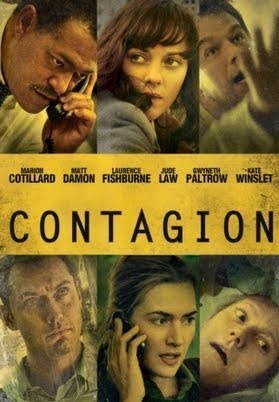
Marion Cotillard in a
scene from Contagion in which she plays a doctor searching for the
origin of the virus. Photograph: Warner Bros/Sportsphoto Ltd/Allstar
It's a classic Hollywood tale: scientists race against time to
decode a killer virus that is spreading across the world. But the
scientist who advised Oscar-winning director
Steven Soderbergh on his new thriller,
Contagion, says the events and themes of his latest film carry a very real warning for our times.
- Contagion
- Production year: 2011
- Countries:
Rest of the world, USA
- Cert (UK): 12A
- Runtime: 106 mins
- Directors: Steven Soderbergh
- Cast: Bryan Cranston, Gwyneth Paltrow,
Jennifer Ehle, John Hawkes, Jude Law, Kate Winslet, Laurence Fishburne,
Marion Cotillard, Matt Damon
- More on this film
Dr Ian Lipkin, professor of epidemiology, neurology and
pathology at New York's Columbia University, was recruited as a senior
technical adviser on Soderbergh's blockbuster. The film, which opened in
cinemas on Friday, charts the emergence of a deadly infectious disease
that ignites a pandemic.
Scientists are first alerted after Beth
Emhoff, played by Gwyneth Paltrow, becomes sick after returning from a
business trip to Hong Kong and dies two days later. As the virus quickly
spreads and the death toll rises, it is down to a team of scientists –
including Dr Erin Mears, played by Kate Winslet – to decode the virus so
that a vaccine can be produced.
According to Lipkin, the plot is
anything but unrealistic. Virus outbreaks are an increasing threat in
the 21st century, he says, because of greater international trade and
travel, urbanisation, loss of wildlife habitats and inadequate
investment in infrastructure for surveillance, vaccine production and
distribution.
"Scientists have been accused of overreacting and
crying wolf over the threat of virus outbreaks after the influenza
pandemic of 2009," Lipkin told the
Observer. "
Sars
[Severe Acute Respiratory Syndrome] didn't progress beyond a few
locations, but outbreaks and pandemics will occur and we need to get our
heads out of the sand and realise the real risks that we face. More
than three-quarters of all emerging
infectious diseases originate when microbes jump from wildlife to humans.
"Our
vulnerability to such diseases has been heightened by the growth in
international travel and the globalisation of food production. In
addition, deforestation and urbanisation continue to displace wildlife,
increasing the probability that wild creatures will come in contact with
domesticated animals and humans."
Lipkin says societies need to
be more proactive in combating the dangers. "People need to understand
that science is critical to address these kinds of challenges and
respond in real time," he said. "We need to be prepared. We need better
bio-surveillance, with better detection and better ability to develop
vaccines. However, our public health system is underfunded and
overwhelmed, and we need more scientists."
Lipkin added: "When I
was a kid, the launching of Sputnik made us aware that the United States
was falling behind the Soviet Union in the race for space. Now all of
us are in a battle that is potentially devastating, only it is not
against another country but against microbes."
In
Contagion,
Soderbergh draws on real-life disease outbreaks, including the 2003
Sars epidemic, which started in Hong Kong and spread to 37 countries,
infecting more than 8,400 people and causing 916 deaths.
Lipkin assisted the
World Health Organisation
and the Chinese ministry of health in managing the Sars outbreak, at
some personal peril – he became ill and was quarantined on returning to
the US.
"The events portrayed in this film are based largely on
real experiences," said Lipkin. "For example, there are scenes in the
movie where at the height of the pandemic the streets are deserted,
there are food and supply shortages and political instability, and this
directly comes out of my vivid memories of what it was like in Beijing
during the Sars crisis.
"I was also able to advise actors from
personal experience what it feels like to be quarantined – an eerie
experience where you are behind glass and cut off from loved ones."
Lipkin
is one of the world's foremost microbe hunters and over the past decade
has identified more than 400 new viruses. But unlike British
cosmologist Dr Martin Rees, who controversially predicted in his book
Our Final Hour that civilisation had no more than a 50% chance of surviving until 2100, Lipkin is an optimist.
"Since
the Sars outbreak, there has been increased investment to look at
wildlife around the world and there is better integration between the
different public health agencies both nationally and internationally,"
Lipkin said. "So there is reason to be optimistic, and I believe we can
address the problems.
"We are one world – humans and animals – and
we need to take care of one another. We also, for example, need to
insist that people move away from technologies that slow down the
production of vaccines so that we can develop a vaccine in three months
instead of six."
Contagion pays tribute to the scientists
and public health officials who dedicate their lives to trying to solve
the problem of emerging viruses. Winslet's character is based on
Italian scientist Carlo Urbani, who was the first to identify Sars and
became infected with the disease while treating patients and died aged
46, leaving his wife and three children.
"The most moving portions
of the film were those where I saw people who were very similar to
people whom I've known, people who didn't have well-known names, who
died in the service of science and public health," said Lipkin. "The
film is in some ways a living memorial to them."
